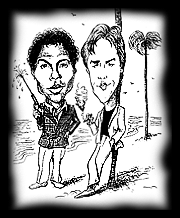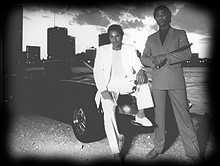Life, of course, is transient. We are blessed, for several decades, to catch breath, learn to speak, socialize with others, and (if lucky), meet another with whom to share love and perhaps remake ourselves in smaller, slightly altered versions. And between attempts at loving and (perhaps) procreating, we work and build careers, and sometimes vacate them temporarily to climb mountains and swim with the fishes in the sea, and otherwise refresh our world-weary souls to return to our lives and move onward towards, well, to move onwards.
But in the meantime, we inhabit periods called decades - neatly parceled tracts of years that come 10 to the century. Decades are odd things. They are odd because the seven that the average American sees come and go before that average American does the same. All decades can and will be considered "defining." They are odd because they rarely are defining. And they are odd because the things that happen within them, and for which they are remembered (the at-the-time-relevant hairstyle, or color palette), never seem to fit neatly within their respective 10-year periods.
 Consider the '70s. They didn't go away so easily. Arguably, it took the first several years of the '80s for the residual effects of bad hair and poorly-woven synthetics to be purged from our collective system. Look at a college or high-school yearbook from 1981 or 1982. See that? Just below the parted hair and the still-too-wide lapel? Yes, friend, it is a poorly attended-to patch of upper-lip hair which we, from our gloriously tasteful perch here in the '90s, would never have thought to see on a human after midnight on December 31, 1979. Yet there it is. Defiant. Proud. Furry. Now look again, friend, at a later yearbook - '85 or maybe '86. Besides a few notable exceptions sported by members of the marginally normal, scraggly upper-lip hair had given way to a much cleaner visage, and collars had narrowed to the point of being nearly absurdly reactionary. The Eighties had arrived.
Consider the '70s. They didn't go away so easily. Arguably, it took the first several years of the '80s for the residual effects of bad hair and poorly-woven synthetics to be purged from our collective system. Look at a college or high-school yearbook from 1981 or 1982. See that? Just below the parted hair and the still-too-wide lapel? Yes, friend, it is a poorly attended-to patch of upper-lip hair which we, from our gloriously tasteful perch here in the '90s, would never have thought to see on a human after midnight on December 31, 1979. Yet there it is. Defiant. Proud. Furry. Now look again, friend, at a later yearbook - '85 or maybe '86. Besides a few notable exceptions sported by members of the marginally normal, scraggly upper-lip hair had given way to a much cleaner visage, and collars had narrowed to the point of being nearly absurdly reactionary. The Eighties had arrived.
September 16, 1984 was the day it all began. For on that day a stylishly scruffy Miami police detective named Sonny Crockett was reluctantly teamed up with flashy New York cop Rico Tubbs to bravely protect us from Colombian baddies and widely-popular musician/guest-stars. Thus came the dawn of style-driven television - a force that would, for years, permeate our airwaves. A force that would cause us all to rethink our roles in the world vis-a-vis Phil Collins. Thus came Miami Vice.
The formula was pretty routine when you think about it, or at least it seems so now. Two people of vastly different backgrounds forced together in pursuit of a common goal - specifically, to live an exorbitant lifestyle on a detective's salary. Yet, in spite of their similar agenda, the two maintained distinctly separate styles. Styles that certainly reflected the deeper yearnings of the public. Specifically again, the need to escape the doldrums of the entertaining - but largely unchallenging - styles of previous cop shows. Let's face it, Starsky and Hutch was great and all, but Huggy Bear wasn't really pushing any hooch that you couldn't see on a Friday night anywhere on 42nd Street. Crockett and Tubbs, on the other hand, took chances. They operated in the far-off land of Miami - a real frontier at the time, that hadn't yet achieved its Sly/Madonna/Delano status it now enjoys (and probably wouldn't if not for M.V.). Their characters careened off into five minute, introspectively-lit-from-below-the-dashboard music video sequences that put Baywatch to shame. Furthermore, they were surrounded by a supporting cast who, in my estimation, altered how we remember the circus that was the "me" decade. Of course, they also helped define the beliefs and styles of the go-go '90s.
 Let's start with the sideshows.There was Lieutenant Castillo, the original Man in Black, the solemn, by-the-book god-figure who was a Reservoir Dog when most were just puppies. His quiet demeanor, pock-marked face, and black and white sartorial habits set him in marked contrast to his flashy environments. He was the firmament to which his space-man detectives could return for counsel. Then there were female sidekicks, Gina and Trudy, the tough yet vulnerable defendresses of righteousness. As feminine reflections of Crockett and Tubbs, they basically served as wallpaper, and occasionally offered real crime-fighting support. Has anyone seem Pamela Anderson's new show? Enter Switek and Zito, the bumbling B team. A pair of jokers who could always be counted on. Latter-day, pre-leading man Sipowiczes, theirs was an unstylish scruff. Real, honest, naked. These two were used mostly for comic effect, but when strings really needed to be pulled, it wasn't unheard of that one of them would get in the way of a stray bullet or two. After all everyone knows it hurts a hell of a lot more to see the clown get bitten than the lion-tamer. These guys represented the scruffy-chic, and were largely attired in shirts from either Hawaii and Cuba - a style which to this day is regarded as hip in certain pockets of humanity.
Let's start with the sideshows.There was Lieutenant Castillo, the original Man in Black, the solemn, by-the-book god-figure who was a Reservoir Dog when most were just puppies. His quiet demeanor, pock-marked face, and black and white sartorial habits set him in marked contrast to his flashy environments. He was the firmament to which his space-man detectives could return for counsel. Then there were female sidekicks, Gina and Trudy, the tough yet vulnerable defendresses of righteousness. As feminine reflections of Crockett and Tubbs, they basically served as wallpaper, and occasionally offered real crime-fighting support. Has anyone seem Pamela Anderson's new show? Enter Switek and Zito, the bumbling B team. A pair of jokers who could always be counted on. Latter-day, pre-leading man Sipowiczes, theirs was an unstylish scruff. Real, honest, naked. These two were used mostly for comic effect, but when strings really needed to be pulled, it wasn't unheard of that one of them would get in the way of a stray bullet or two. After all everyone knows it hurts a hell of a lot more to see the clown get bitten than the lion-tamer. These guys represented the scruffy-chic, and were largely attired in shirts from either Hawaii and Cuba - a style which to this day is regarded as hip in certain pockets of humanity.
It could be argued that the magic of Miami Vice came in the form of the hilariously-cast guest stars who appeared regularly. All facets of society were honored. From the world of music, we got John and Andy Taylor of Duran Duran (in separate episodes), Glen Frey, Phil Collins, Sheena Easton, Miles Davis, James Brown, Gene Simmons, Little Richard, Willie Nelson, Vanity, Ted Nugent, Frank Zappa, and most notably, several members of the Power Station.
Sports figures included washed-up boxer Alexis Arguello, washed-up boxer turned actor Randall "Tex" Cobb, race car driver Danny Sullivan and, in a famously-awful appearance as a corrupt Basketball coach, NBA Hall-of-Famer Bill Russell. There was a young Chris Rock, Penn Jillette (sans Teller), Pam Grier, Clarence Williams III (from The Mod-Squad), Bruce Willis, Lee Iaccocca, Don King, Frank (brother of Sly) Stallone, and Watergate creep G. Gordon Liddy. These guests were the true representation of the impact of this show. We knew them for their "other" lives. Their mainstream, relatively flashless existences. But put into the context of Miami Vice, they became real bad-guys (and they were all cast as bad guys), bejeweled and dressed in shiny suits. It was, in a sense, the ultimate step outside of our collective selves.
But truly, no discussion of this matter could be considered complete without a brief look at the two main characters. There was Rico Tubbs. He of the sharkskin suit and lugubrious New York Style. A crime-fighting chameleon who could easily slip into the smoooooth Jamaican cadence of his cover-Jamaican drug-lord, Rico Cooper. Tubbs was a nice character. A good foil, but little more than that. He was a bit too much like the guy who hangs out with the guy who gets things done. You know the one: standing back and to the right, punctuating threats with a steady stream of fist into palm thuggery and a "yeah, what he said" smirk. But that was his role. And it was played nicely by the nearly forgotten Phillip Michael Thomas, a sort of fringe star who, it seemed, was destined to end up hawking promise for the Psychic Friends Network.